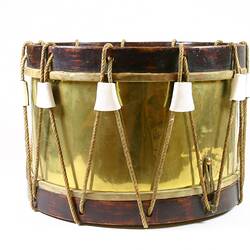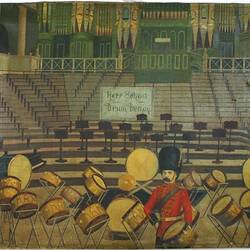The opening ceremony of the Exhibition included the premiere of the 'Centennial Cantata', especially composed for the Exhibition by Reverend William Allen. This was the first performance of a major work by a Melbourne-born composer. (Colligan 1996a, p. 215) The theme of the 'Centennial Cantata' was the coming of European civilisation. (Dunstan 1996, p.194) The lyrics described in six parts the solitary past of the Australian continent, before colonisation led to the development of a 'national history'. (McDonald 2001, p.48) The cultural authority of the Exhibition would lead the international guests to believe that Australia had a history and identity as reflective of the best parts of European culture.
The musical offerings of the Exhibition provided both unsurpassed pleasure and educational opportunity for the Victorian public. (Radic 1977, vol.2, p.12) New music was composed by the Centennial Orchestra's conductor Frederick Cowen and performed alongside traditional composers. There were performances of all the Beethoven symphonies, and symphonies by Schubert, Brahms, Schumann and Wagner were premiered. (Colligan 1996a, p.216) The Argus praised Cowen for his 'sound generalship in the planning of his campaign' by introducing heavier pieces intermittently with lighter music. (Colligan 1996a, p.217) The orchestra reportedly lacked early cohesion, but soon established itself as disciplined. (Colligan 1996a, p.215) An Argus review of an October performance of music by Wagner, Mozart and Delibes was deemed to be 'very interesting' with 'showy movements being encored and repeated', which in doing so 'gave great satisfaction to [the] large evening audience'. (Argus, 6 Oct 1888)
The Centennial Orchestra performed (for the first time for many Australian audiences) 'serious' musical pieces (Colligan 1996a, p. 217). Beethoven's 'Pastoral Symphony' and Wagner's Overture to 'Tannaeuser', noted as being widely popular in Europe, were very popular with Melbourne audiences, a sign that Australian audiences were developing a 'love for, the best music' (1890, p. 264). Two months into the Exhibition, The Argus reported that 'the general public, amongst whom were many excursionists, were treated to well-practised and highly finished performances of the following well known selections, namely: Prelude to Longengrin and overture to Tannhaeuser by Wagner; the Ballet Air no. 1, from Rosamund Music, by Schubert; The Hungarian Rhapsody no. 3 in D, the Turkish Rondo from a pianoforte sonata by Mozart; and also music by Delibes. (Argus, 6 Oct 1888)
In total, 211 orchestral, 30 grand choral and 22 'popular' concerts were performed under Cowen's direction. (1890, p.263)
References
1890. The Official Catalogue of the Centennial International Exhibition Melbourne 1888-1889, Mason, Firth and M'Cutcheon, Melbourne
The Argus (2 August 1888). 'Exhibition Supplement'.
The Argus. (6 October 1888). 'Orchestral Concert'.
Colligan, Mimi. (1996a). 'More Musical Entertainments' in Victorian Icon: The Royal Exhibition Building, ed. David Dunstan. Melbourne: The Exhibition Trustees.
Dunstan, David. (1996). 'Doing it all over Again' in Victorian Icon: The Royal Exhibition Building, ed. David Dunstan, The Exhibition Trustees, Melbourne
Ehrlich, Cyril. (1995). First Philharmonic: A History of the Royal Philharmonic Society, Oxford University Press, Oxford
MacDonald, Anna. (2001). Seeing Melbourne: The Centennial International Exhibition and the Cyclorama of Early Melbourne. Unpublished MA Thesis, University of Melbourne.
Radic, Maureen Therese. (1977). 'Some Aspects of Musical Associations in Melbourne 1888-1915'. Unpublished PhD Thesis, University of Melbourne.
More Information
-
Keywords
-
Authors
-
Article types


